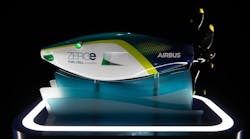SAN DIEGO, 20 Sept. 2012. U.S. Navy maritime communications experts are canvassing industry to find companies able to provide Link 11 and Link 22 radio digital data link capability for the Navy's Next Generation Command and Control Processor (NGC2P) for shipboard communications and situational awareness.
The Space and Naval Warfare Systems Command (SPAWAR) issued a request for information Tuesday (SPAWAR_Headquarters_MKTSVY_C74E2) for the Link 11 and Link 22 Data Terminal Set (DTS) for Next Generation Command and Control Processor (NGC2P) program, which seeks to identify companies with Link 11 and Link 22 Tactical Digital Information Link (TADIL) capability.
The request for information (RFI) is part of Navy market research to determine industry solutions available to provide Link 11 and Link 22 Data Terminal Set (DTS) capability to NGC2P systems, which are being produced by the Northrop Grumman Corp. Information Systems Sector in McLean, Va.
The NGC2P is a tactical data link (TDL) communication processor for U.S. and allied surface warships that provides real-time information about friendly and enemy activity during combat operations. The program is to upgrade fielded systems with additional TDL capabilities.
Link 11 -- otherwise known as TADIL-A -- is a secure half-duplex TADIL HF or UHF radio link used by NATO that exchanges digital information among aircraft, land-based, and shipboard tactical data systems. It relies on one platform to report positional information on sensor detections.
Link 22, meanwhile, is the next-generation NATO HF and UHF tactical data link that will use a Time Domain Multiple Access (TDMA) architecture for data communications over extended ranges. Link 22, unlike Link 11, will perform simultaneous different transmission on as many as four networks to increase bandwidth. Link 22 ultimately is intended to replace Link 11.
Link 11 transmits data at 1.1 or 1.8 megabits per second in HF mode, while Link 22 transmits data at 1.5 to 4.1 megabits per second in HF mode. Link 22 also can transmit data at 12.7 megabits per second in UHF radio mode.
The SPAWAR RFI will help Navy officials determine the technical approaches and possible solutions to meet the government's needs for providing the Link 11 and Link 22 software and hardware components for the NGC2P. The RFI is solely for information and planning purposes, and is nor a formal solicitation.
Link 11 capability is embedded in the NGC2P embedded system processor group (ESPG) in some configurations, while Link 22 will be implemented in the NGC2P with testing scheduled for 2017.
SPAWAR primarily is interested in industry proposals on single solutions which provide a dual Link 11/Link 22 capability, as well as separate or federated solutions which provide Link 11 and Link 22 capabilities.
Companies interested should respond to SPAWAR with white papers no later than 19 Oct. 2012. Send white papers electronically via the SPAWAR E-CC website at https://e-commerce.spawar.navy.mil/
For questions or concerns contact SPAWAR Contract Specialist Mark Schweer by phone at 619-524-7165. More information is online at https://www.fbo.gov/spg/DON/SPAWAR/SPAWARHQ/SPAWAR_Headquarters_MKTSVY_C74E2/listing.html.
Follow Military & Aerospace Electronics and Avionics Intelligence news updates on Twitter



